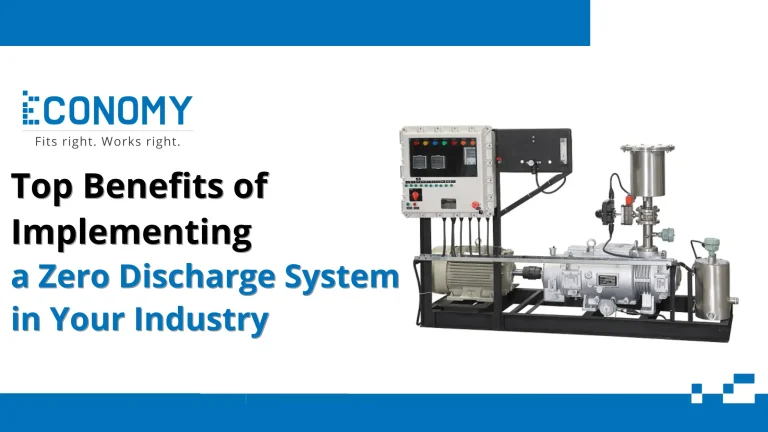Understanding Zero Discharge Systems
A Zero Discharge System (ZDS) is an advanced wastewater treatment process designed to eliminate liquid discharge from industrial operations. This system ensures that all wastewater is treated, reused, or evaporated, preventing environmental contamination. The concept of zero discharge has gained prominence as industries face stringent environmental regulations and increasing water scarcity. By implementing such a system, industries can significantly reduce their ecological footprint while optimizing water and resource utilization.
Key Components of a Zero Discharge System
A Zero Discharge System integrates several advanced treatment processes to ensure complete elimination of liquid waste. It typically includes pre-treatment processes such as filtration and chemical treatment to remove solids and contaminants. Advanced filtration methods like reverse osmosis (RO) and ultrafiltration (UF) help separate clean water from impurities. Evaporation and crystallization units are used to concentrate and recover valuable byproducts while ensuring that no liquid waste is released. Additionally, sludge management systems treat and dispose of solid residues efficiently, making the system sustainable and cost-effective in the long run.
Why Industries Need a Zero Discharge System
Industries worldwide are under increasing pressure to comply with environmental regulations and reduce their impact on natural resources. A Zero Discharge System helps industries meet these stringent discharge norms while minimizing their dependence on freshwater sources. Many industries generate large volumes of wastewater containing hazardous chemicals and pollutants that can harm ecosystems if discharged untreated. By adopting a zero discharge approach, industries can not only comply with legal requirements but also demonstrate corporate social responsibility. Furthermore, the rising costs of water procurement and wastewater treatment make zero discharge a financially viable option in the long term.
Key Advantages of a Zero Discharge System
Implementing a Zero Discharge System offers numerous benefits to industries. One of the primary advantages is water conservation, as the system enables the reuse of treated water, reducing dependence on external water sources. This is particularly beneficial in regions facing water scarcity. Additionally, a ZDS significantly reduces pollution levels by preventing the discharge of toxic effluents into water bodies, thereby protecting aquatic life and maintaining ecological balance. Another major advantage is cost savings. While the initial investment in a zero discharge setup may be high, industries can achieve substantial long-term savings on wastewater disposal and water procurement costs. The recovery of valuable byproducts from waste streams also presents an opportunity for additional revenue generation. Moreover, adopting a zero discharge approach enhances a company’s reputation, positioning it as an environmentally responsible organization committed to sustainable practices.
Benefits of Zero Discharge Systems in Industries
Several Benefits of Zero Discharge Systems in Industries stand to benefit significantly from the implementation of Zero Discharge Systems. The textile industry, for instance, generates large amounts of wastewater laden with dyes and chemicals, making it a prime candidate for ZDS adoption. Similarly, chemical and pharmaceutical industries produce hazardous effluents that require complete treatment to prevent environmental contamination. The power generation sector, particularly thermal power plants, also benefits from zero discharge practices by optimizing water reuse and reducing environmental impact. Other industries such as food processing, metal finishing, and mining can also gain from implementing ZDS by improving wastewater management and regulatory compliance while reducing operational costs.
How to Implement a Zero Discharge System in Your Industry
Implementing a Zero Discharge System requires a strategic approach tailored to the specific needs of an industry. The first step involves conducting a comprehensive wastewater audit to analyze the composition and volume of effluents generated. This helps in selecting the appropriate treatment technologies. Next, industries should invest in advanced filtration and separation technologies such as reverse osmosis, evaporation, and crystallization to ensure maximum water recovery and pollutant removal. Proper integration of these components is crucial to achieving zero discharge effectively. Additionally, industries must focus on optimizing process efficiency to minimize waste generation at the source. Regular monitoring and maintenance of the system ensure its long-term effectiveness. Partnering with experienced wastewater treatment solution providers can further streamline the implementation process, ensuring compliance with environmental standards and enhancing overall operational efficiency.
Conclusion
The adoption of a Zero Discharge System is a crucial step toward sustainable industrial operations. By eliminating wastewater discharge, industries can significantly reduce their environmental impact while conserving water and resources. The benefits of implementing ZDS extend beyond regulatory compliance, offering cost savings, improved resource efficiency, and enhanced corporate reputation. As environmental concerns continue to grow and regulations become stricter, industries must proactively invest in zero discharge solutions to secure a sustainable future. Through proper planning and the integration of advanced treatment technologies, businesses can successfully implement a Zero Discharge System and reap its long-term benefits.


